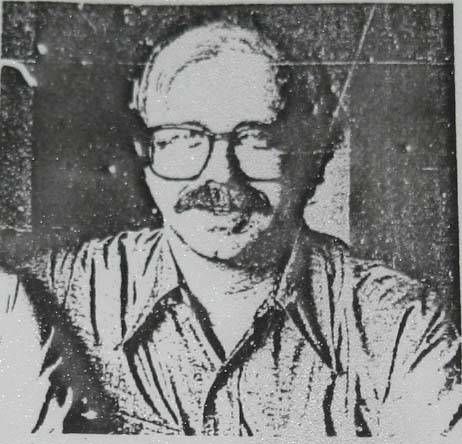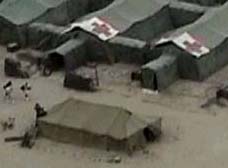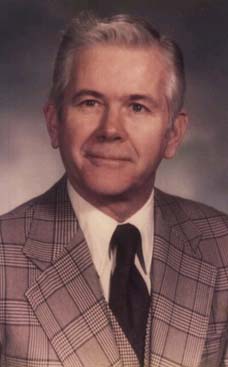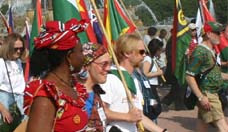
Stansell, Gonsalves and Howes are the first American contractors captured in the Colombian conflict, in which $2.5 billion in U.S. aid has gone to fight drug trafficking and buttress Colombian security forces against armed groups, including FARC, over the past four years. They are contract employees of California Microwave Systems, a subsidiary of the defense giant Northrop Grumman, the private company that ran the Southcom Reconnaissance System under a Defense Department contract for intelligence gathering in rebel-held areas.
The fate of the U.S. captives in Colombia is complicated by their status as contractors, not soldiers. The government contends it is doing all it can.
CITIZENS, NOT SOLDIERS
The fate of the U.S. captives in Colombia is complicated by their status as contractors, not soldiers. The government contends it is doing all it can.
Tuesday November 11, 2003
By John McQuaid
Staff writer
Three Americans held hostage by narco-guerrillas in the thick jungles of southeastern Colombia for the past nine months live an endless cycle of tedium and anxiety, interrupted only by meals, prayers, sleep and, reportedly, occasional travel from one thatch-roofed prison to the next.
"I've never gone through anything worse," hostage Keith Stansell said on a videotape made in July by a Colombian journalist. "You sit, day in and day out, and I look at my two friends here, and at the end of the day we think to ourselves, we're alive another day. Will we be alive tomorrow? Do we have a future? Can we see our families?"
The hostages -- Stansell, Marc Gonsalves and Thomas Howes -- were captured by guerrillas of the Revolutionary Armed Forces of Colombia, known by its Spanish acronym FARC, when their surveillance plane crashed Feb. 13. American pilot Tom Janis and Colombian Army Sgt. Luis Alcides Cruz were shot and killed by FARC forces.
Stansell, Gonsalves and Howes are the first American contractors captured in the Colombian conflict, in which $2.5 billion in U.S. aid has gone to fight drug trafficking and buttress Colombian security forces against armed groups, including FARC, over the past four years. They are contract employees of California Microwave Systems, a subsidiary of the defense giant Northrop Grumman, the private company that ran the Southcom Reconnaissance System under a Defense Department contract for intelligence gathering in rebel-held areas.
The hostage-taking reflects the changing face of the U.S. presence in Colombia and other trouble spots around the world. Private contractors, rather than government or military personnel, are increasingly on the front lines of drug and terrorism fighting, as well as reconstruction and peacekeeping efforts.
Pawns of war
Because they are not soldiers, critics say, they receive less media and official attention when they are killed or captured.
"These guys are classified by the U.S. government as kidnapped," said Deborah Avant, a political scientist at George Washington University who studies private military companies. "If they were active-duty personnel it would be different. They would be prisoners of war. There's a different level of concern. Think of the difference between Jessica Lynch and these guys."
A State Department official bluntly disputed that idea. "I can't imagine there would be more concern for a career person than for these three guys," he said. "That's the kind of allegation that I resent because it sort of questions our honor, that we would try to use a contractor who's expendable. In a sense we're all expendable when we take jobs like this that are risky. But there's no difference on how we react to the loss of a contractor versus a civil servant versus a foreign service officer versus an active-duty military."
Stansell, Gonsalves and Howes are now pawns in the drug war, a source of continuing anxiety for the U.S. government and agonizing waits for family members.
Meanwhile, U.S. efforts to free the hostages have been limited by policy proscriptions against negotiating with groups designated terrorists. A rescue attempt would be very dangerous. Some family members are angry with the government and California Microwave Systems for what they see as a lack of action to resolve the situation and a failure to explain the circumstances that led to the crash.
"I have e-mailed President Bush 50, 60 times," said Jo Rosano, Gonsalves' mother, who lives in Bristol, Conn. "I think they don't value their lives. It's like lives were dispensable -- and my son's life is not dispensable."
Large swaths of southeastern Colombia are ruled by FARC, a 40-year-old insurgent group with a force estimated at about 12,000 fighters scattered around the country. "It's Farclandia down there. It's their ballgame," said Tom Marks, a military analyst and expert on Colombian counterinsurgency efforts.
In recent years FARC has all but abandoned its original goal of socialist revolution and morphed into a militarized criminal enterprise. FARC forces oversee an empire founded on drugs and kidnapping that pulls in more than $1 billion a year. They oversee and tax the cultivation of coca and opium poppy used to make heroin, and run a network of drug labs that refine the raw product. Lately a Colombian Army push into rebel-held areas has been putting pressure on FARC.
Engine died
The Southcom surveillance program was created to gather intelligence on this region, and the airplane crews always ran a risk of an encounter with the people they were spying on.
Firsthand information on the events of the crash has come from the kidnapped crew members themselves. Interviews videotaped in late July by Colombian journalist Jorge Enrique Botero was made into a documentary by American producers Victoria Bruce and Karin Hayes, who aired excerpts on CBS and a documentary on the History Channel last month.
The airplanes in the program were based in Bogota but flew their missions out of Colombian military bases, including one named Larandia in the province of Caqueta. On Feb. 13, their plane was on its way to refuel at Larandia and was flying at less than 5,000 feet when trouble began.
Stansell was sitting at a computer console in the rear of the plane along with Gonsalves and Cruz when, he told Botero, "I heard the . . . the engine make a distinct sound as far as quitting. It just . . . it quit. It got real quiet. I looked at Marc. Marc was looking at me for an answer, so I asked the pilot, 'What's going on?' The pilot, Tom Janis . . . said, 'Sir, that's an engine failure.' "
Members of the Teofilo Forero mobile column -- a specialized, well-trained unit of FARC -- were meeting with another unit in the jungle nearby. They spotted the plane as it descended and shot at it, according to a defense analyst familiar with U.S. activities in Colombia who asked not to be identified.
"There's an intercepted FARC communication," the analyst said. "The commander says, there's a plane flying around, presumably conducting an intelligence mission. Do I have permission to shoot at it? Then he gets permission, and firing is heard on the intercept."
It's not clear if any FARC shots hit the plane before it crashed. Bullet holes were found in the plane, but that could also mean the FARC forces shot-up the hull after the crash.
"Tommy Janis, the pilot, saw on his side of the aircraft a postage stamp-sized open area of green grass," Howes said. "He decided that immediately that would be the place. My feeling was there was a good chance we weren't going to survive the landing."
Stansell radioed the base, declared an emergency and reported the plane's location. "Tom advised us, 'Guys, hold on. This is going to be very hard. We're going to hit very hard,' and that was it. We . . . we hit the ground," Stansell said. "I remember, when we hit the ground, the airplane opening up and dirt and debris flying inside."
Stansell and Cruz got out and glanced through the windshield, where Howes lay unconscious, with cuts on his face, a broken nose and broken teeth.
Critical delays
The guerrillas were on them almost immediately.
Howes and Janis were pulled from the plane. Howes was reunited with Stansell and Gonsalves. But Janis and Cruz were not. "That's the last time I saw the Colombian and Tommy Janis," Stansell said. "When I looked back at both of them, they had their hands up and they were being marched toward us, but they were still a long distance from us."
The captives were force-marched on a 24-hour journey during which Stansell, with two broken ribs, had to be carried, according to an article written by Botero. That night, "We asked the leader of the group what happened," Stansell said. "They explained to us that Tommy and the Colombian were dead. We didn't ask any more questions. We were in fear and we had nothing more to say."
The two men's bodies were found near the crash site with gunshot wounds. It is unclear why they were shot.
"We do know Sgt. Cruz was injured, and injured sufficiently that he could probably walk real slowly and sort of limp along," another State Department official said. Even if he had been able-bodied, the FARC, which sometimes executes captured Colombian military officers, might not have let him live.
Janis would have been more valuable to FARC as a hostage, so his killing is harder to explain. "That's why we can't figure it out," the official said. "Did he try and help Cruz? Was he older, and they didn't think he was as physically fit as the others and couldn't move as quick? Was he injured too and we didn't pick that up? We don't know."
Janis' wife, Judith, said she believes her husband, a dynamic former Special Forces officer, probably tried to escape. "In my mind he resisted being captured. That's what he would do," she said.
Colombian government helicopters were in the air above the site 35 minutes after the crash, Gen. James Hill, the commander of Southcom, told Congress in March.
However, John McLaughlin, the recently retired chief of the State Department's Colombia-based air wing, said in a letter to Congress that U.S.-supported Colombian rescue helicopters were delayed 15 minutes with their engines running, awaiting clearance from Colombian officials -- which he said could have made a difference in the rescue.
"When finally released, the gunships arrived overhead after two of the crew had been executed and just in time to see the three surviving . . . captives being led off by their FARC captors," McLaughlin wrote. "It is important to realize that (State Department) air wing gunships have successfully extracted personnel . . . under very heavy contact situations before. With proper planning, training, and SOPs (standard operating procedures) in place, this outcome could have been different."
Forces did not land until several hours later.
McLaughlin said in an interview that the takeoff delay reflects the lack of an established rescue protocol for such emergencies in Colombia, with the exception of coca spray planes, which have helicopter gunship escorts. If a plane goes down, he said, crews can call the nearest base for help.
There is an informal understanding among U.S. and Colombian personnel that help will be sent, McLaughlin said, but no written agreements or contingency plans. "It was all unofficial, the guys in the field looking out for each other," he said.
Robert Charles, the assistant secretary of state overseeing counternarcotics, said he did not know the details of what happened, but that "my understanding is that a response was timely." Charles, a recent appointee, said interagency cooperation in such situations is one of his priorities.
With guidance and aid from the United States, the Colombians mounted a search with ground troops including more than 2,000 members of the U.S.-trained 12th and Antidrug Brigades. One-hundred-fifty U.S. troops were dispatched to Colombia to aid the search, and Congress relaxed caps on the number of troops and contractors.
But from the beginning, rescuing the captives was a formidable task.
Americans high-value captives
FARC has made a business of kidnapping, which after drug trafficking is the source of hundreds of millions of dollars annually. This year alone, it has kidnapped 1,481 people, including 22 foreigners. It holds 23 politicians and 40 soldiers.
American hostages are a strategic prize, a tool to be used for brinkmanship with the Colombian and U.S. governments. On Feb. 21, FARC issued a communiqué announcing the capture of the plane crew and demanding military operations in the area be stopped. In other communiqués the guerrillas have sought to exchange the hostages for imprisoned FARC commanders and to wrap them into a swap with other prominent captives in exchange for the release of a large number of lower-level FARC commanders and troops.
By most accounts guerrilla commanders handled the Americans carefully, in keeping with their overall strategy. In the videos, the hostages appear healthy, have short haircuts and are dressed in camouflage fatigues.

"Historically, the FARC has kept all its kidnap victims alive," said Garry Leech, the editor of Colombiareport.org, an online newsletter. "Occasionally they get killed or die trying to escape, or they may shoot them when there's a rescue attempt. Otherwise they have a pretty good record of trying to keep them alive. They are very businesslike. Ninety percent of those do get out alive. They've kept some prisoners alive for years."
In mid-March, the second Southcom surveillance plane joined the search, partly at the behest of crew members eager to get back in the air and help rescue their coworkers. Ten days later that plane crashed, killing three more Americans from the program.
Like most hostage-takings in Colombia, the situation is basically a standoff.
"We have a very clear idea about where they are being held," Colombian Defense Minister Martha Lucia Ramirez said Friday. "But our armed forces' first priority is to avoid a military operation that could expose them to severe risk."
Ramirez resigned Sunday for reasons unrelated to the hostage situation.
Penetrating FARC defenses on the ground is tricky, and arriving by helicopter is so noisy that it can eliminate the element of surprise.
In May, one such rescue attempt went awry and FARC executed 10 hostages, including the governor of Antioquia province, a former defense minister and eight soldiers after rebels heard helicopters approaching.
A rescue attempt by U.S. forces also is a possibility, observers say, but it would probably cause friction with the Colombian government.
The U.S. has designated FARC a terrorist group and officials have said there will be no negotiations.
"We have made it clear through both public and private channels to the FARC that we want these individuals freed and we hold them ultimately responsible for their well-being," a State Department official said. He said the United States has stressed to FARC that "there will be a price to be paid down the road for the killing of one American and the holding of the others."
The State Department is working through various contacts to free the hostages. Recently a reward offered for information leading to their release was increased from $300,000 to $5 million.
'Dead time'
Northrop Grumman spokesman Jack Martin said in a written statement that the company is cooperating with government agencies on the hostage situation. "We remain concerned about the health and well-being of Keith, Marc and Tom and will continue to use every means available to us in seeking the release by the FARC of these three civilian noncombatants so that they might be safely reunited as soon as possible with their families," he said.
The Colombian government and the Catholic Church have also made attempts to reach out to FARC commanders, but without notable success.
Some of those who have been held hostage and eventually released describe as the norm moving often through the jungle, a poor diet, bouts with tropical diseases, and constant insect bites. The Southcom hostages described generally good living conditions in their interview, but it was conducted in the presence of FARC guerrillas, and U.S. officials regard their statements as coerced.
Gonsalves is married and has a young daughter. Howes and his wife have a 6-year-old son. Stansell, who is divorced, has two children.
"I live in a vacuum, dead time," Howes told Botero. Amid the boredom, they described small rituals that kept them going. Gonsalves said he begins each day by opening a notebook in which he has drawn a picture of his house. "I open to that page and I say good morning to my family," he said. "Then I pray and eat breakfast."
. . . . . . .
John McQuaid can be reached at john.mcquaid@newhouse.com or (202) 383-7889.










